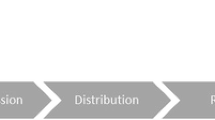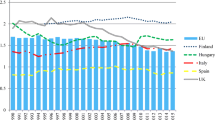Abstract
Electricity utilities are key players for promoting energy efficiency (EE) because of their close link to consumers. Utility-centered EE policy frameworks, such as white certificate schemes coupled to saving obligations, have been shown to be both effective and efficient in several US states and various European countries. In Switzerland, where such a policy framework is absent on a national level, large differences occur among utility providers in their activities to promote EE. This study sheds light on this issue, using data from a survey of Swiss utilities (N = 114). A two-step cluster analysis was used to identify three groups of utilities. It is based on these utilities’ evaluation of 20 incentives and constraints for promoting EE. An analysis of variance found significant differences between the clusters regarding size (number of employees), share of production, number of large clients, and—most importantly—level of activity in implementing EE programs. The most active cluster comprises mainly larger utility companies, which primarily see the incentives of promoting EE. The passive cluster consists of small companies, focusing primarily on constraints. There is also an ambivalent cluster. It includes middle-sized companies, which see both clear incentives and many constraints – mainly a lack of human and capital resources—for engaging in EE. Based on our analysis, we conclude that due to the large heterogeneity of Swiss utilities, there is a need for contextualized policies targeting different types of utilities in order to effectively promote EE.



Similar content being viewed by others
Notes
In this article, we use the term utilities to refer to electricity companies with a retail function, regardless of whether they are as well energy producers or provide other utility services, such as gas or water.
Although Cooremans does not explicitly address energy utilities but rather focuses on companies in general, her argument is still valid, as EE programs might be a strategic means for utilities to set them apart from competitors.
We estimated this number based on data published in the annual reports and on the websites of these utilities.
References
Aragón-Correa, J. A., Hurtado-Torres, N., Sharma, S., & García-Morales, V. J. (2008). Environmental strategy and performance in small firms: a resource-based perspective. Journal of Environmental Management, 86(1), 88–103.
Bertoldi, P., & Rezessy, S. (2009). Energy saving obligations and tradable white certificates. Report prepared by the Joint Research Centre of the European Commission. Brussels: European Commission.
Bertoldi, P., Rezessy, S., Lees, E., Baudry, P., Jeandel, A., & Labanca, N. (2010). Energy supplier obligations and white certificate schemes: comparative analysis of experiences in the European Union. Energy Policy, 38(3), 1455–1469.
BFE. (2012). Schweizerische Elektrizitätsstatistik 2011 [Swiss Electricity Statistics 2011]. Bern: Bundesamt für Energie.
Bianchi, R., & Noci, G. (1998). "Greening" SMEs' competitiveness. Small Business Economics, 11(3), 269–281.
Cabrera, D., Seal, T., Bertholet, J.-L., Lachal, B., & Jeanneret, C. (2012). Evaluation of energy efficiency program in Geneva. Energy Efficiency, 5(1), 87–96.
Carley, S. (2012). Energy demand-side management: new perspectives for a new era. Journal of Policy Analysis and Management, 31(1), 6–32.
Cometta, C., Hannich, F., & Rauh, M. (2010). Smart Metering: (K)ein Thema für Schweizer Energieversorger [Smart metering—(not) a focus of Swiss energy suppliers]? Bulletin VSE/electrosuisse, 12, 1–4.
Cooremans, C. (2011). Make it strategic! Financial investment logic is not enough. Energy Efficiency, 4(4), 473–492.
Crossley, D. J. (2008). Tradeable energy efficiency certificates in Australia. Energy Efficiency, 1(4), 267–281.
Eurelectric. (2011, September 16, 2013). The promotion of energy efficiency services—a survey among electricity companies. http://www.eurelectric.org/media/26220/energy_efficiency_survey_lr-2011-030-0376-01-e.pdf
Field, A. (2009). Discovering statistics using SPSS. London: SAGE Publications Ltd.
Fthenakis, V., & Kim, H. C. (2009). Land use and electricity generation: a life-cycle analysis. Renewable and Sustainable Energy Reviews, 13(6–7), 1465–1474.
Giraudet, L. G., Bodineau, L., & Finon, D. (2012). The costs and benefits of white certificates schemes. Energy Efficiency, 5(2), 179–199.
Hopper, N., Barbose, G., Goldman, C., & Schlegel, J. (2009). Energy efficiency as a preferred resource: evidence from utility resource plans in the Western US and Canada. Energy Efficiency, 2(1), 1–16.
Horowitz, M. (2011). Measuring the savings from energy efficiency policies: a step beyond program evaluation. Energy Efficiency, 4(1), 43–56.
Jaffe, A. B., & Stavins, R. N. (1994). The energy-efficiency gap. What does it mean? Energy Policy, 22(10), 804–810.
Kaufman, N., & Palmer, K. (2012). Energy efficiency program evaluations: opportunities for learning and inputs to incentive mechanisms. Energy Efficiency, 5(2), 243–268.
Laager, D., Bettler, M., Carle, G., Meier, M., Miguel, S., Wiederkehr, K., & Wittwer, R. (2009). Befragung zur Bedeutung von Energieeffizienz in der Strombranche [Survey on the relevance of energy efficiency in the energy sector]. Aarau: Verband Schweizer Elektrizitätsunternehmen.
Mundaca, L. (2008). Markets for energy efficiency: exploring the implications of an EU-wide ‘Tradable White Certificate’ scheme. Energy Economics, 30(6), 3016–3043.
Nabe, C., Beyer, C., Brodersen, N., Schäffler, H., Adam, D., Heinemann, C., et al. (2009). Einführung von lastvariablen und zeitvariablen Tarifen [Introduction of variable tariffs with respect to load and time]. Bonn: Deutsche Bundesnetzagentur für Elektrizität, Gas, Telekommunikation, Post und Eisenbahnen.
Pavan, M. (2012). Tradable white certificates: experiences and perspectives. Energy Efficiency, 5(1), 83–85.
Pyrko, J., & Darby, S. (2011). Conditions of energy efficient behaviour—a comparative study between Sweden and the UK. Energy Efficiency, 4(3), 393–408.
Sonderegger, R. W. (2005). Minimale wirtschaftliche Grösse von EVU—Wie gross muss ein kommunales EVU sein, um wirtschaftlich überleben zu können [Minimal size of municipal utilities—how large must they be in order to survive]? Bulletin VSE/electrosuisse, 20(2005), 1–2.
Sonderegger, R. W., & Schedler, K. (2010). Betriebliche Steuerung von kommunalen Elektrizitätsversorgungsunternehmen—Schlussbericht zur Follow-up Studie 2009 [Operational management of Swiss utilities—final report of the follow-up study 2009]. St. Gallen: Universität St. Gallen.
Sorrell, S., Schleich, J., Scott, S., O’Malley, E., Trace, F., Boede, E., et al. (2000). Reducing barriers to energy efficiency in public and private organizations. Brighton: SPRU, Univ. of Sussex.
SPSS Inc. (2001). The SPSS two-step cluster component: a scalable component to segment your customers more effectively. White Paper, Technical Report. Chicago: SPSS.
Suerkemper, F., Thomas, S., Osso, D., & Baudry, P. (2012). Cost-effectiveness of energy efficiency programmes—evaluating the impacts of a regional programme in France. Energy Efficiency, 5(1), 121–135.
Sullivan, D., Wang, D., & Bennett, D. (2011). Essential to energy efficiency, but easy to explain: frequently asked questions about decoupling. The Electricity Journal, 24(8), 56–70.
Swissgrid. (2012). Jahresbericht 2011 [2011 Annual Report]. Frick: Swissgrid.
Swiss Federal Council. (2013). Botschaft zum ersten Massnahmenpaket der Energiestrategie 2050 und zur Atomausstiegsinitiative [Message to the parliament on the first package of measures for implementing the Energy Strategy 2050 and to the initiative for phasing out nuclear power]. Bern: Swiss Federal Council.
Tan, J., & Peng, M. W. (2003). Organizational slack and firm performance during economic transitions: two studies from an emerging economy. Strategic Management Journal, 24(13), 1249–1263.
Tian, Z., Ramakrishnan, R., & Livny, M. (1997). BIRCH: a new data clustering algorithm and its applications. Data Mining and Knowledge Discovery, 1(2), 141–182182.
Ürge-Vorsatz, D., & Metz, B. (2009). Energy efficiency revisited: how far does it get us in controlling climate change? Energy Efficiency, 2(4), 287–292.
Vine, E., Hall, N., Keating, K., Kushler, M., & Prahl, R. (2012). Emerging issues in the evaluation of energy-efficiency programs: the US experience. Energy Efficiency, 5(1), 5–17.
Vojdani, A. (2008). Smart integration. Power and Energy Magazine, IEEE, 6(6), 71–79.
Waide, P., & Buchner, B. (2008). Utility energy efficiency schemes: savings obligations and trading. Energy Efficiency, 1(4), 297–311.
Weber, L. (1997). Some reflections on barriers to the efficient use of energy. Energy Policy, 25(10), 833–835.
Yergin, D. (2006). Ensuring energy security. Foreign Affairs, 85(2), 69–82.
Zarnikau, J. (2012). The many factors that affect the success of regulatory mechanisms designed to foster investments in energy efficiency. Energy Efficiency, 5(3), 393–410.
Acknowledgements
This study is based on a project under the umbrella of ETH Seed Sustainability (http://www.seed.ethz.ch). We thank all the experts involved in the study, particularly Roger Sonderegger for his help with the design of the survey. We extend our thanks to Roman Seidl, Timo von Wirth, Jörn Hoppmann, Bastian Girod, and Nina Boogen for their valuable comments and feedback on previous versions of the manuscript and Christine Gmür for proofreading the final manuscript. The authors would also like to acknowledge the very detailed and helpful feedback offered by five anonymous reviewers.
Author information
Authors and Affiliations
Corresponding author
Electronic supplementary material
Below is the link to the electronic supplementary material.
ESM 1
(DOCX 504 kb)
Rights and permissions
About this article
Cite this article
Blumer, Y.B., Mühlebach, M. & Moser, C. Why some electricity utilities actively promote energy efficiency while others do not—a Swiss case study. Energy Efficiency 7, 697–710 (2014). https://doi.org/10.1007/s12053-013-9249-z
Received:
Accepted:
Published:
Issue Date:
DOI: https://doi.org/10.1007/s12053-013-9249-z




